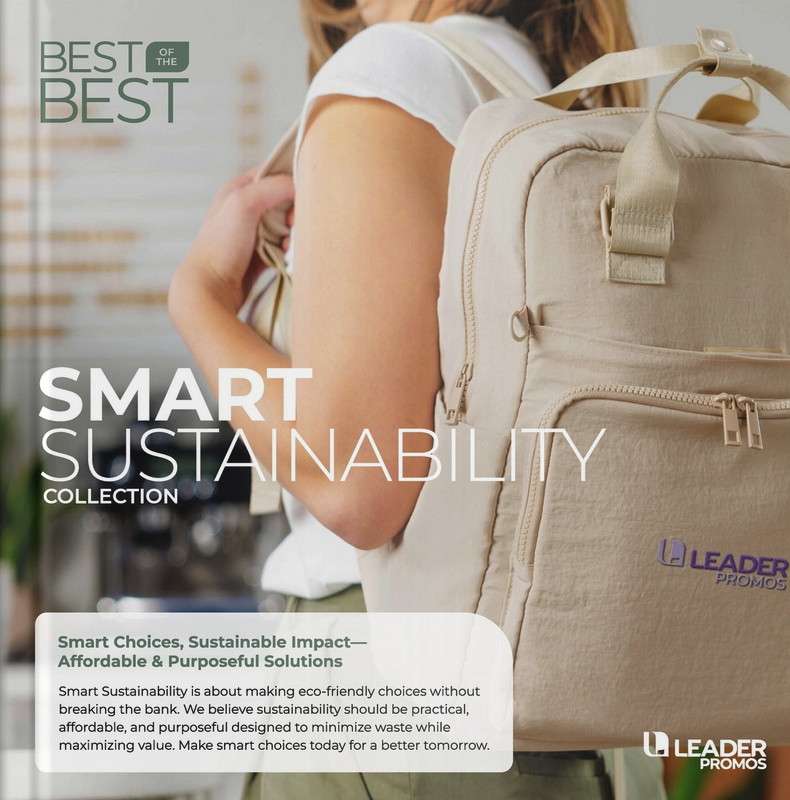The ROI of Sustainable Branded Merchandise
Why Green Merch Matters to Everyone
We live in a world where lasting brand impressions are made in just seconds.
In this world where consumer values are shifting so rapidly, branded merchandise remains a powerful tool for connection. But the game has changed. Today’s audiences aren’t just looking for clever design or utility—they’re looking for consciousness. Sustainable merchandise isn’t just a trend; it’s a strategic investment in your brand’s future.
The Shift in Employee and Consumer Expectations
Modern employees and consumers—especially Millennials and Gen Z—are increasingly aligning their purchasing decisions with their values. According to Nielsen, nearly 75% of Gen Z are willing to pay more for sustainable products. Even more importantly, 70% of Gen Z and Millennials consider environmental sustainability important when choosing potential employers (Deloitte Survey). Branded merchandise is no exception. A reusable water bottle made from recycled materials or a responsibly sourced hoodie says more about your brand than a thousand words of copy.
Gone are the days of plastic pens and throwaway trinkets. Today’s audiences expect brands to walk the talk when it comes to sustainability. And when they don’t? The backlash can be swift and public, and the risk of losing employee employer trust can be real.
What Makes Merch “Sustainable”?
Sustainability in merchandise isn’t just about materials—it’s about the entire lifecycle. Here’s what to look for:
Reusable Materials: Glass, Aluminum, Stainless Steel, Cotton, Hemp, Jute, Bamboo, Oak, Cork, Ceramics, and Natural Stones
Recyclable Materials: PET, PET Felt, Fabrics, Papers, ABS, Glass, Cardboard, Metals, and Plastics
Production: Ethical labor practices, low-impact dyeing, and energy-efficient manufacturing.
Lifecycle: Products designed to last, be reused, or easily recycled.
Packaging: Minimal, recyclable, or compostable packaging that complements the product’s ethos.
Printing: Use sustainable inks, recycled and FSC-certified papers, use energy-efficient printing processes, use non-toxic finishes, and when possible use local and ethical production.
Shipping and Distribution: Minimize the carbon-footprint of production and shipping or off-set the carbon footprint as much as possible. Employ smart inventory and on-demand as much as possible to avoid over production, reduce storage and other energy needs.
When merch is thoughtfully designed and responsibly produced, it becomes more than a giveaway—it becomes a statement, and a standard.
The Business case for Sustainable Merchandise
Sustainable merch isn’t just good for the planet—it’s good for business. Here’s how:
Brand Perception: Eco-conscious merch signals that your brand is forward-thinking and values-driven.
Customer Loyalty: Consumers are more likely to support brands that reflect their personal ethics.
Employee Engagement: Internally, sustainable merch can boost morale and reinforce company culture.
Cost Efficiency Over Time: While sustainable items may cost more upfront, their durability and brand impact often outweigh the initial investment.
Marketing ROI: Unique, sustainable items are more likely to be shared on social media, used regularly, and remembered—amplifying your brand’s reach organically.
Wonderful Real-World Examples
Brands like Patagonia, Allbirds, Rothy’s, Timbuk2, and Storm Creek have built entire ecosystems around sustainability. Patagonia’s upcycled gear program turns old products into new ones, while Allbirds labels each item with its carbon footprint. These aren’t just merch—they’re brand stories in physical form.
Even smaller brands are making waves. Local coffee shops offering reusable mugs with clever messaging, or indie studios creating limited-edition recycled notebooks, are finding that sustainable merch builds deeper connections.
Real World Case-Studies
Patagonia:
“Don’t Buy This Jacket” Campaign
Strategy: Encouraged consumers to reduce consumption and repair existing gear.
Sustainable Merch: Promoted recycled fleece and organic cotton products.
ROI Impact: Despite the anti-consumption message, Patagonia saw increased brand loyalty and sales. Their Worn Wear program also extended product life and reduced waste.
Key Takeaway: Radical transparency and sustainability can paradoxically drive growth.
Cotopaxi:
Repurposed Fabric Backpacks
Strategy: Every product is made from 100% repurposed materials, with unique colorways chosen by the makers.
Sustainable Merch: Batac backpacks and other gear made from factory remnants.
ROI Impact: Strong brand differentiation and emotional connection with consumers; increased social media engagement due to the uniqueness of each item.
Key Takeaway: Sustainability plus storytelling creates memorable merch.
Courant:
Sustainable Tech Accessories
Strategy: Used Belgian linen and biodegradable flax in tech accessories.
Sustainable Merch: Wireless chargers and organizers made from eco-friendly materials.
ROI Impact: Elevated brand perception in the premium tech space while aligning with sustainability values.
Key Takeaway: Eco-conscious design can coexist with luxury and functionality.
Common Pitfalls to Avoid
Greenwashing: Avoid vague claims like “eco-friendly” without backing them up. Transparency is key.
Overproduction: Even sustainable items become waste if they’re unused or irrelevant.
Lack of Storytelling: Don’t miss the opportunity to connect the merch to your brand’s mission. Every item should have a reason for being.
Don’t be Low-Key about It: Be proud of the efforts and accomplishments and make sure you tell everyone about it. Take credit because its not only important for your brand, but you are leading by example. Let your employees know what they are getting, send out press releases for major sustainable projects, and be overt about your plans for the future.
How to Get Started
Ready to start your Purpose-Driven Branded Merchandise™ journey? Start Here.
Vet Your Partners: Ask about certifications, sourcing, production, and shipping practices.
Align with Your Brand Values: Choose items that reflect your brand’s tone, audience, and purpose.
Think Long-Term: Design merch that people will want to keep, use, and talk about.
Tell the Story: Use packaging, tags, and digital content to explain the sustainability journey.
Walk the Talk
Sustainable branded merchandise isn’t just a nice-to-have—it’s a strategic move that pays dividends in brand equity, consumer trust, and long-term impact. As expectations evolve, brands that embrace sustainability in the gifts and merchandise they provide will stand out—not just for what they give, but for what they stand for.
Learn more about how LeaderPromos is walking the talk, our B Corp Certification, and what we are doing every day to manage our overall impact.
LeaderPromos will help you get started (or fulfill) your sustainability journey. Start Here.


